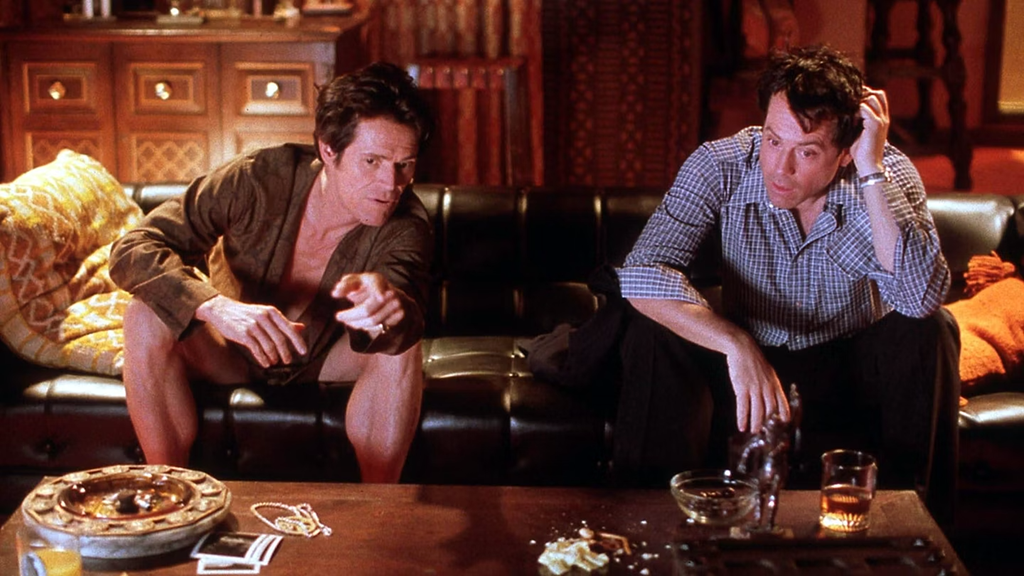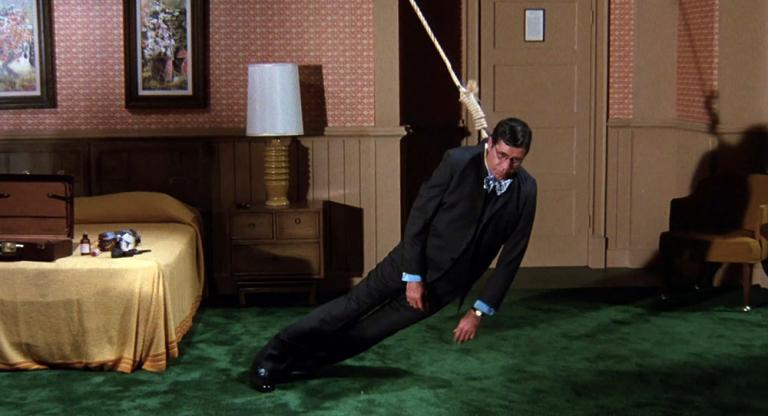In 1978, on a languorous Arizona summer day, a 49-year-old man was found dead in his Scottsdale apartment. The victim was laid out on his bed: battered, scarred, and with an electrical cord left coiled around his neck. Though the corpse was nearly unidentifiable, police were soon informed that the body belonged to Robert Crane, the once beloved star of CBS’s hit WWII POW-sitcom Hogan’s Heroes (1965). While Paul Schrader’s biopic of the TV personality, Auto Focus (2002), creates its own narrative surrounding Crane’s still unsolved murder, the film’s primary interest lies in the actor’s fragile double life.
Following a Saul Bass-inspired title sequence, the film starts with Crane (Greg Kinnear) DJ-ing for a local-Hollywood FM station. The middle-aged actor and radio personality, dressed in bright colored cardigans, appears to lead the picture-perfect, mid-century suburban lifestyle. He drives a station wagon, plays the drums as a hobby, and attends church services with his family. However, when he hits peak stardom during the run of Hogan’s Heroes, Crane’s veneer of all-American congeniality begins to crumble. After he befriends the video-equipment salesman John Carpenter (Willem Dafoe), the actor is quickly brought into the world of cutting edge video cameras and promiscuous nightlife outings. To Crane’s family, his newfound companion is just a fellow shutterbug who helps them install new video recording equipment in their living room, allowing them to preserve cherished domestic memories. Yet, unbeknownst to everyone else, Carpenter is a self-destructive catalyst for Crane, taking him down a path of serial sex addiction and amateur pornogaphy.
In a DVD making-of featurette for Auto Focus, Dafoe describes his scenes with Kinnear as “domestic scenes.” Crane and Carpenter, two men with no shortage of libido and desperate thirst for social validation, interact the same way a toxic couple would. Crane needs Carpenter to supply and maintain his high-tech home video kit, and Carpenter rides off his clout. It’s a textbook transactional relationship. After helping Crane get drumming gigs at local sex clubs, the two begin to initiate regular evening rendezvous where they bring women home and put Carpenter’s cameras to the test. When the former’s marriage falls apart, they spend even more time together, bickering under the same roof, only to film sexual escapades later that same evening. Dafoe and Kinnear display a perfectly awkward erotic synergy. This latent tension permeates the film, but never crosses the threshold of Hollywood’s heteronormative boundaries. Crane comfortably goes about his sexual exploits alongside Carpenter, often sharing moments that are both physically and emotionally intimate. The moment Carpenter tries to make advances on Crane during one of their evenings of wanton adultery, he is vitriolically repudiated as a “feygele.”
This portrait of vice is as much a character study of Crane as it is a window into the contradictory moral forces tugging at the United States in the ‘60s. While Hollywood diverted its gaze from sexual desires that ran rampant in seedy strip clubs located in its own backyard, it openly romanticized war in shows like Hogan’s Heroes (a family friendly comedy set in a Nazi prison camp.) In an era during which the United States’ bloody military footprint imprinted itself across the globe, scandal lay in a man’s hidden sexual proclivities. Throughout Auto Focus, the nuclear family, with its pastel home decor, white picket fences, and leather-upholstered diner booths, is constantly juxtaposed with the surging undercurrents of repressed carnal desires. The arrival of home video technology in the ‘60s blurred the lines between domestic safe spaces and sites of taboo desires, meaning that the same handheld camera capable of recording cherished childhood memories also began to immortalize an underground culture of hedonism.
Auto Focus screens tonight, February 17, at Anthology Film Archives on 35mm as part of the series “Wild at Heart: Willem Dafoe.”



